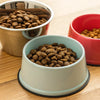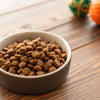Can You Mix Wet and Dry Dog Food? Exploring the Benefits and Best Practices
- Houndsy
Table of Contents
- Introduction
- The Nutritional Landscape: Wet vs. Dry Dog Food
- Considerations When Mixing Wet and Dry Dog Food
- How to Mix Wet and Dry Dog Food Properly
- Common FAQs About Mixing Wet and Dry Dog Food
- Conclusion
Introduction
Did you know that a dog's diet can significantly impact their overall health, mood, and behavior? It’s true! As pet owners, we often find ourselves grappling with the question of how to best nourish our furry friends. Among the myriad choices available, one popular feeding practice is mixing wet and dry dog food. This approach can entice even the pickiest eaters and provide a well-rounded nutritional profile. But can you mix wet and dry dog food safely?
In this blog post, we will delve into the benefits of mixing wet and dry dog food, explore the science behind it, and provide practical tips for ensuring your dog receives the ideal balance. By the end, you’ll have a comprehensive understanding of this feeding strategy and how it can benefit your beloved pet. So, let’s reflect on your dog’s current feeding routine—could it use a little variety or enhancement?
The Nutritional Landscape: Wet vs. Dry Dog Food
Before we dive into the specifics of mixing, it’s crucial to understand the fundamental differences between wet and dry dog food.
What is Dry Dog Food?
Dry dog food, often referred to as kibble, is a staple in many households. It typically contains around 10-12% moisture and is convenient to store and serve. Here are some key characteristics:
- Shelf Life: Dry food has a longer shelf life, making it easy to keep on hand without worrying about spoilage.
- Dental Health: The crunchy texture of kibble can help reduce plaque and tartar buildup on your dog’s teeth, promoting better oral health.
- Cost-Effective: Generally, dry dog food is more economical than wet food, allowing for larger quantities to be purchased without breaking the bank.
What is Wet Dog Food?
Wet dog food, on the other hand, has a higher moisture content—often between 75-78%. It comes in various forms, including pâtés, chunks in gravy, or meat-based soups. Here’s why some pet owners prefer wet food:
- Palatability: The rich aroma and texture of wet food can make it more appealing to dogs, especially those that are finicky eaters or have decreased appetite due to health issues.
- Hydration: The higher water content helps keep dogs hydrated, which is particularly beneficial for those with kidney problems or urinary issues.
- Easier to Chew: Wet food can be easier to chew for puppies, senior dogs, or those with dental problems, ensuring they receive adequate nutrition without struggle.
The Benefits of Mixing Wet and Dry Dog Food
Now that we understand the characteristics of each food type, let’s explore the advantages of combining them.
- Enhanced Flavor and Texture: Mixing wet and dry food offers a diverse meal experience for your dog. The combination of crunchy kibble and soft wet food can make mealtime more enticing, especially for picky eaters.
- Balanced Nutrition: By blending the two, you can provide a more comprehensive nutritional profile. Dry food often contains essential nutrients and vitamins, while wet food can contribute additional hydration and flavor.
- Encourages Hydration: For dogs that may not drink enough water, mixing wet food can help increase their overall fluid intake, promoting better kidney and urinary health.
- Variety in Diet: Just like humans, dogs can become bored with their meals. Mixing wet and dry food can introduce new flavors and textures, keeping your dog excited about mealtime.
- Cost-Effective Solutions: If your dog prefers the taste of wet food, mixing it with dry kibble can allow you to use less wet food while still satisfying their cravings, helping you save on costs.
Considerations When Mixing Wet and Dry Dog Food
While there are numerous benefits to mixing wet and dry dog food, there are also some considerations to ensure a safe and healthy feeding routine.
Monitor Portion Sizes
Understanding the right portion sizes is essential to avoid overfeeding. A general guideline is to maintain a ratio of approximately 75% dry food to 25% wet food, but this can vary based on your dog’s specific needs. Consulting your veterinarian for tailored advice is always a good practice.
Nutritional Balance
When mixing foods, ensure both the wet and dry options are nutritionally complete and balanced. Look for products that meet AAFCO (Association of American Feed Control Officials) standards, which indicate that the food provides adequate nutrition for your dog’s life stage.
Storage and Freshness
One drawback of wet dog food is its limited shelf life once opened. Unused portions should be refrigerated and consumed within a few days. Dry food, in contrast, lasts longer, so make sure to store it in a cool, dry place to maintain freshness.
Health Conditions and Dietary Restrictions
If your dog has specific health concerns or is on a therapeutic diet, consult your veterinarian before mixing different foods. Certain conditions may require strict adherence to specific diets, and mixing could dilute therapeutic benefits.
How to Mix Wet and Dry Dog Food Properly
Now that we’ve covered the benefits and considerations, let’s discuss how to effectively mix wet and dry dog food.
Step-by-Step Guide
- Choose High-Quality Products: Start with high-quality wet and dry dog foods that meet your dog’s nutritional requirements. Look for brands that prioritize ingredient quality, like Houndsy, to ensure your dog receives the best.
- Determine the Right Ratio: Based on your dog’s specific needs, calculate the appropriate portion sizes for both wet and dry food. Remember, a common starting point is 75% dry and 25% wet.
- Mix It Up: In a clean bowl, combine the measured portions of wet and dry food. You can add water to the mixture if desired to enhance hydration and flavor.
- Serve Fresh: Serve the mixed meal immediately to prevent spoilage. If your dog doesn’t finish the meal, discard any leftovers after a few hours to avoid bacterial growth.
- Observe Your Dog: Pay attention to how your dog reacts to the mixed meal. Look for signs of enjoyment, and ensure there are no digestive issues. If your dog seems to struggle with the new mix, adjust the ratio or consider sticking to one type of food.
Common FAQs About Mixing Wet and Dry Dog Food
Is it safe to mix wet and dry dog food?
Yes, mixing wet and dry dog food is generally safe for healthy dogs. However, it’s essential to ensure both food types are nutritionally balanced and appropriate for your dog’s specific dietary needs.
Will mixing food help my picky eater?
Absolutely! Mixing wet and dry food can make meals more enticing for picky eaters. The combination of textures and flavors often appeals to their preferences, encouraging them to finish their meals.
How do I store opened wet food?
Once opened, wet dog food should be refrigerated and used within a few days. Be sure to cover the container to maintain freshness.
Can I mix different brands of dog food?
Mixing different brands is generally acceptable, but ensure both meet your dog’s nutritional needs and that you’re aware of any dietary restrictions.
What if my dog has health issues?
Always consult your veterinarian before making changes to your dog’s diet, especially if they have specific health concerns or are on a therapeutic diet.
Conclusion
Mixing wet and dry dog food can be a fantastic way to elevate your dog’s mealtime experience while ensuring they receive balanced nutrition. The combination offers a variety of flavors and textures that can entice even the fussiest eaters while providing hydration and a well-rounded diet. Remember to monitor portion sizes and consult with your veterinarian for any specific dietary needs.
Ready to enhance your dog’s feeding routine? Explore the innovative Houndsy Kibble Dispenser, designed to simplify the feeding process while maintaining style and convenience. Let’s elevate your dog’s mealtime experience together! Order Now.
By thoughtfully considering how to mix wet and dry dog food, we can make mealtime not just a necessity but a joy for our furry companions. Happy feeding!













